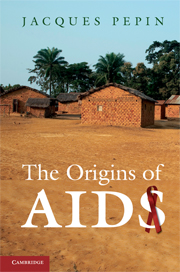Book contents
- Frontmatter
- Contents
- Figures, maps and table
- Acknowledgements
- Abbreviations
- Note on terminology
- Introduction
- 1 Out of Africa
- 2 The source
- 3 The timing
- 4 The cut hunter
- 5 Societies in transition
- 6 The oldest trade
- 7 Injections and the transmission of viruses
- 8 The legacies of colonial medicine I
- 9 The legacies of colonial medicine II
- 10 The other human immunodeficiency viruses
- 11 From the Congo to the Caribbean
- 12 The blood trade
- 13 The globalisation
- 14 Assembling the puzzle
- 15 Epilogue
- References
- Appendix Classification of retroviruses
- Index
4 - The cut hunter
Published online by Cambridge University Press: 05 June 2012
- Frontmatter
- Contents
- Figures, maps and table
- Acknowledgements
- Abbreviations
- Note on terminology
- Introduction
- 1 Out of Africa
- 2 The source
- 3 The timing
- 4 The cut hunter
- 5 Societies in transition
- 6 The oldest trade
- 7 Injections and the transmission of viruses
- 8 The legacies of colonial medicine I
- 9 The legacies of colonial medicine II
- 10 The other human immunodeficiency viruses
- 11 From the Congo to the Caribbean
- 12 The blood trade
- 13 The globalisation
- 14 Assembling the puzzle
- 15 Epilogue
- References
- Appendix Classification of retroviruses
- Index
Summary
The next question to be addressed is: how did the virus cross species to infect humans? How did the simian immunodeficiency virus of P.t. troglodytes chimps become the human immunodeficiency virus type 1? Again, science started out with an intuition: this must have occurred through the handling of chimpanzee meat by hunters, or their wives who would cut up the animals before cooking them. We will now examine whether this theory remains plausible after reviewing the various pieces of evidence accumulated over the past decade.
Hunters and their prey
Hunters and/or cooks can acquire infectious agents from their prey, including primates. For instance, Herpes B virus is a rare but highly lethal infection of individuals who handle monkeys, and especially laboratory technicians working with rhesus and cynomolgus macaques. Monkeypox is a smallpox-like but benign viral infection associated with exposure to monkeys. Highly lethal Ebola and Marburg haemorrhagic fevers have been reported in veterinarians and villagers who handled the carcasses of apes that had died in the wild from these infections. Recently, a retrovirus called simian foamy virus (SFV) has been associated with human exposure to monkeys and apes, and its sequencing allows the identification of the exact simian source. American veterinarians and animal caretakers working in primate centres or zoos were found to be infected with SFV acquired from chimpanzees. Fortunately, this virus does not seem to be pathogenic for humans, and no person-to-person transmission has ever been documented.
- Type
- Chapter
- Information
- The Origins of AIDS , pp. 43 - 58Publisher: Cambridge University PressPrint publication year: 2011



